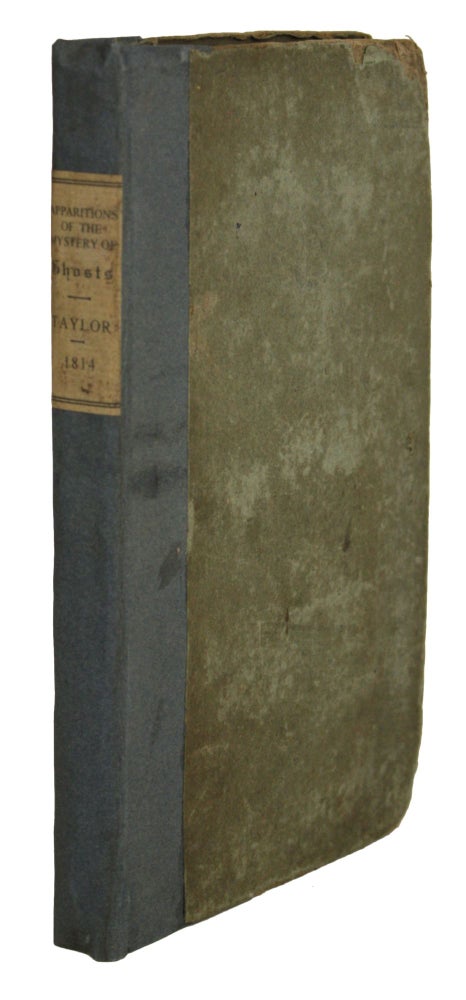APPARITIONS; OR, THE MYSTERY OF GHOSTS, HOBGOBLINS, AND HAUNTED HOUSES, DEVELOPED. BEING A COLLECTION OF ENTERTAINING STORIES, FOUNDED ON FACT; AND SELECTED FOR THE PURPOSE OF ERADICATING THOSE RIDICULOUS FEARS, WHICH THE IGNORANT, THE WEAK, AND THE SUPERSTITIOUS, ARE BUT TOO APT TO ENCOURAGE, FOR WANT OF PROPERLY EXAMINING INTO THE CAUSES OF SUCH ABSURD IMPOSITIONS. London: Printed by Macdonald and Son, Cloth Fair, for Lackington, Allen, and Co., Finsbury Square, 1814. 12mo, pp. [i-iii] iv-xi [xii] [13] 14-223 [224-226: ads], inserted engraving, "The Haunted Beach," drawn by C. Knight and engraved by H. Corbould, original drab boards with new back-strip and new paper label, untrimmed. First edition. A collection of credulous ghost stories based on UK legends and folklore, an early forerunner of similar compilations of "true" ghost stories by Catherine Crowe and Elliott O'Donnell. "When Horace Walpole used all the apparatus of Gothic fantasy in THE CASTLE OF OTRANTO (1765) he created a literary vehicle for ghosts without establishing the ghost story; the spectres were merely a stage effect. But they now became the stock-in-trade of the Gothic school of writing. In these novels a haunted edifice was an inevitable centerpiece. In most cases the hauntings were contrived by human agency or the ghost had a walk-on part in order to provoke the action; in much fewer cases were the ghost genuinely supernatural, with a more significant role. Most of these books were formulaic and repetitive, but a few are worthy of note... Although the better Gothics also utilized ghosts, these were usually rationalized. The use of sheeted spectres, wailing phantoms, rattling chains and gibbering skeletons reduced the supernatural element to burlesque, and the Gothic ghost story was soon parodied in such works as NIGHTMARE ABBEY (1818) by Thomas Love Peacock and NORTHANGER ABBEY (1818) by Jane Austen. Rudolph Ackermann published GHOST-STORIES; COLLECTED WITH A PARTICULAR VIEW TO COUNTERACT THE VULGAR BELIEF IN GHOSTS AND APPARITIONS ... (1823) in an effort to counter the excesses of the Gothic story. In the UK the ghost story was as much influenced by folk tales and legend as by the Gothic romance. A number of Ghost Stories were collected in the same manner as the Grimm Brothers compiled their folk tales, and presented in narrative form. The main folklorists reporting these tales included James Hogg in WINTER EVENING TALES (1820) and THE SHEPHERD'S CALENDAR (1828), the brothers John and Michael Banim in REVELATIONS OF THE DEAD-ALIVE (1824) and T. Crofton Croker in FAIRY LEGENDS AND TRADITIONS OF THE SOUTH OF IRELAND (1825). Their stories take the form of reportage of folk legends, but became increasingly humanized. The best-remembered collector of ghost stories was Catherine Crowe, with her highly influential THE NIGHT SIDE OF NATURE (1848), LIGHT AND DARKNESS (1850) and GHOSTS AND FAMILY LEGENDS (1858). These set the trend for "real" ghost stories related in fictional narrative form, an approach that became very popular in the 1890s ..." - Clute and Grant (eds), The Encyclopedia of Fantasy (1997), p. 403. Eaton Catalogue 3: 344. Not in Bleiler (1948; 1978) or Reginald (1979; 1992). Block, The English Novel 1740-1850 (listing the 1815 enlarged second edition). Wolff 6671 (listing the 1815 edition). Signature of C. F. Cooper dated October 1814 on the front free endpaper. Boards worn and soiled, expertly rebacked. A nice copy overall. (#170090).
Price: $550.00
No statement of printing.


